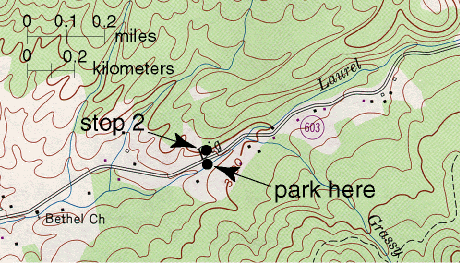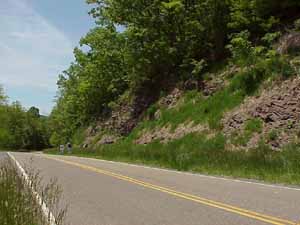 Directions: Park on the left (eastbound) side, where there is a wide gravel area (a pull-off) that can accomodate several vehicles. The large outcrop is on the right, across the road (ever notice how the outcrop is ALWAYS on the other side of the road? Extra credit if you can imagine why...and no, it has nothing to do with geologists or chickens crossing the road!). Be cautious when crossing; there are curves at each end of the stretch of road, and cars are moving rather quickly through here. Directions: Park on the left (eastbound) side, where there is a wide gravel area (a pull-off) that can accomodate several vehicles. The large outcrop is on the right, across the road (ever notice how the outcrop is ALWAYS on the other side of the road? Extra credit if you can imagine why...and no, it has nothing to do with geologists or chickens crossing the road!). Be cautious when crossing; there are curves at each end of the stretch of road, and cars are moving rather quickly through here. |
||||||||||||||||
|
||||||||||||||||
| Geology preview: the outcrop at this stop is of the middle to upper part of the Konnarock Formation. Although it's age is not precisely known, it rests above the Mount Rogers Formation (thus, it is younger than 760 m.y.), and is overlain by the Unicoi Formation (which makes it older than 570 m.y.). Refer to the Konnarock Formation pages to get a more complete discussion.
What is of note at this outcrop in the Konnarock are the maroon and grayish-green bands seen in the rock. The bands alternate in a cyclical way and are quite monotonous. What is especially impressive to Blue Ridge geologists is how well preserved these things are. Normally the Blue Ridge is extensively metamorphosed, destroying almost all of the sedimentary layering that might be in the original rock. Thus, a well-preserved outcrop like this is a rare window into the sedimentary history of the Blue Ridge. |
||||||||||||||||
| Answer the questions below. As before, you may check your answers by clicking the "answer" link for each one. But, :- ) | ||||||||||||||||
|
|
||||||||||||||||
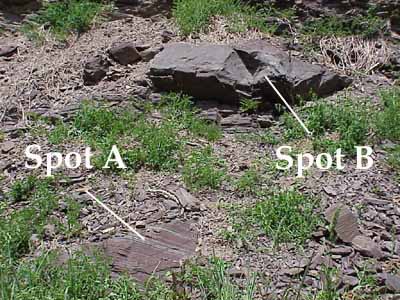 Go to spot A (which you can see in the photo) and note the maroon - greenish gray banding. Look closely at the maroon bands. What rock is this, and what environment of deposition might have formed this? (Hints: gently run your fingers over the rock. Note the difference in how the marron bands feel versus the green-ish gray bands. For you virtual geologists, the maroon bands feel quite smooth while the green bands have a slightly rough feel. Now think about the sedimentary conditions that are conducive for depositing grains sizes like these.) Answer Go to spot A (which you can see in the photo) and note the maroon - greenish gray banding. Look closely at the maroon bands. What rock is this, and what environment of deposition might have formed this? (Hints: gently run your fingers over the rock. Note the difference in how the marron bands feel versus the green-ish gray bands. For you virtual geologists, the maroon bands feel quite smooth while the green bands have a slightly rough feel. Now think about the sedimentary conditions that are conducive for depositing grains sizes like these.) Answer |
||||||||||||||||
|
|
||||||||||||||||
|
Look at the greenish-gray beds (the photo below is taken from Spot A). What is the grain size of this, and how might this form? Once again, remember how the beds feel. Take a real close look. Can you see any of the grains? (Yes, you can, If you look with a hand lens, you can make out the little sediment grains.) Answer
|
||||||||||||||||
|
|
||||||||||||||||
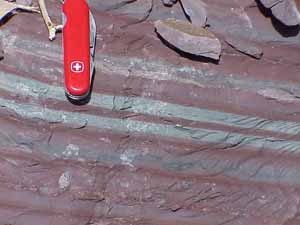 Now, how do we form these alternating mud - silt layers? (Think of something that happens in a cold place.) Answer Now, how do we form these alternating mud - silt layers? (Think of something that happens in a cold place.) Answer |
||||||||||||||||
|
|
||||||||||||||||
|
Okay, lets head upslope a little, to spot B. This rock is overall distinctly rougher feeling and a bit coarser than what we saw before. What rock is this? Note near the bottom of the bed. There are oval shaped pieces of red mud (similar to the marroon beds found at spot A) embedded in the main sediment. How might something like this form? What does this imply about the energy of the current that deposited this sediment? Answer
|
||||||||||||||||
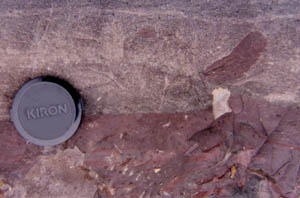 |
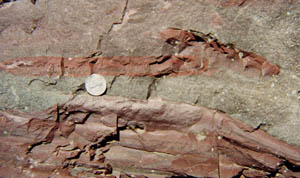 |
|||||||||||||||
| Other things to look at around this outcrop: you can find several examples of soft-sedimentary deformation (see picture on left). The sediment was water saturated, and if it had gotten stirred or compressed unevenly, the original bedding planes became distorted. Dropstones can be found here also, but better ones can be seen at stop 3. | ||||||||||||||||
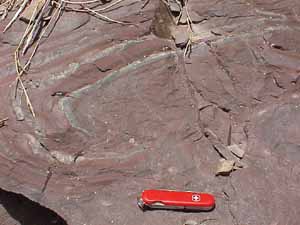 |
||||||||||||||||
 |
||||||||||||||||
